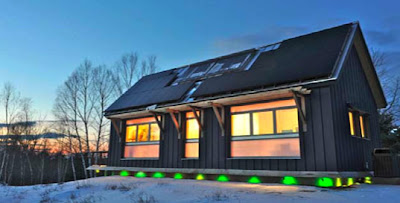Through my Twitter account, I came across the Inhabitat blog a few weeks ago, and now it's my favorite site in the eco-blogosphere. They cover all kinds of green-related stuff, but by far my favorite thing about their site is their weekly "Prefab Friday" specials. As a six-year veteran of the prefab business at Palm Harbor Homes, Inc., I have a natural bias towards these posts, but look at how cool these buildings are (my comments below each):

It's a green houseboat for Pete's sake!

Ultra-modern, ultra-green, award-winning "Spoorhouse."

Prefab home built in Australia.

Shipping container buildings (yes, it's a house, a "Weekend House" as a matter of fact).

The lights under the home indicate whether the house is producing more energy than it's using (green) or consuming more than it's producing (red). Now, I don't see much of a market for this, but it's cool in a crazy green kind of way.

The adaptable R-house is made of sustainable wood and can change shape based on sun position and wind patterns. Wow!

"Cottage in a Day" utilizes structural insulated panels (SIP's).

They actually had this home set-up at the International Builders' Show in Vegas.
I've long been a believer in the power of Prefab/modular technology to revolutionize the homebuilding industry. The fact that this type of construction is really leading the way in the green/sustainable building movement, makes me even more of a believer. I'm just glad to have such cool blogs out there to keep me informed about these cool builders.



5 comments:
Is that grass on the roof of the houseboat?
Grass or Herb?
A huge benefit of building homes in a factory is the ability to monitor quality control. Imagine if you could take a test and be qualified to manufacture automobiles and sell them to people in your community. Cars would not be as efficient or safe as they are (and they've got a long way to go). The same goes for builders. Some builders are great. Most cut corners to save money. Inspectors on the take, etc. This way, you've got a way to ensure that the insulation goes in the walls and attic space. Windows are sealed. Doors are installed properly. All this at a cost that can be substantially less than a typical site-built home.
Nice article Mike.
@Ryan, yes I believe that to be a green roof of some sort.
@Trevor, great points. The traditional site-built construction industry reminds me a lot of the pre-Henry Ford assembly line days in the auto industry. In those days, auto builders brought various contractors into their shops to do custom fabrications. The contractors worked on the cars in stationary spots in the shop (like you would see at a mechanic shop nowadays). Each contractor was typically a highly-skilled craftsman who had perfected his own way of doing things. Cars were expensive and took a while to complete.
Then, Henry Ford comes along, standardizes equipment/tools/fittings/etc., and ultimately puts the cars on a moving assembly line. The cost and time to complete a car come down dramatically and the auto revolution is underway.
Likewise, we in the building business bring in skilled contractors to perform work on stationary homes. Homes are expensive and take forever to complete. Not only that, but as Trevor pointed out, quality can suffer greatly in this non-standardized system.
Prefab building has a lot of potential to lower costs, reduce lead time, and improve quality. The downside is the "trailer park" legacy. It's a huge marketing dilemma, but the green builders featured on the Inhabitat blog are blowing right through these barriers and impressing the heck out of a lot of folks.
Yeah those homes are all amazing. Mike and/or Trevor I would like to see an extended post on why prefab is the way of the future (besides what you have already mentioned here).
I don't know how it works in the residential construction side of things, but in the commercial arena inspectors take their jobs very seriously. I've walked many an inspection with many an inspector looking at everything from concrete foundations to electrical conduits to structural welds to roofing installation to openings (windows/doors) to site and building utilities, and I'm telling you that these people are meticulous as hell. There are no short cuts, and there is no completing a building until every single damn inspection has been walked and approved.
Post a Comment